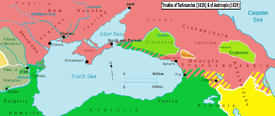Treaty of Adrianople (1829)


The Treaty of Adrianople (also called the Treaty of Edirne) concluded the Russo-Turkish War of 1828–29, between Russia and the Ottoman Empire. It was signed on 14 September 1829 in Adrianople by Count Alexey Fyodorovich Orlov of Russia and by Abdülkadir Bey of the Ottoman Empire.[2] The Ottoman Empire gave Russia access to the mouths of the Danube and the fortresses of Akhaltsikhe and Akhalkalaki in Georgia. The Sultan recognized Russia's possession of Georgia (with Imeretia, Mingrelia, Guria) and of the Khanates of Erivan and Nakhichevan which had been ceded to the tsar by Persia in the Treaty of Turkmenchay a year earlier.[3] The treaty opened the Dardanelles to all commercial vessels, thus liberating commerce for cereals, livestock and wood. However, it took the Treaty of Hünkâr İskelesi (1833) to finally settle the Straits Question between the signatories.
Under the Treaty of Adrianople, the Sultan reguaranteed the previously promised autonomy to Serbia, promised autonomy for Greece, and allowed Russia to occupy Moldavia and Wallachia until the Ottoman Empire had paid a large indemnity. However, under the modifications the later Treaty of Hünkâr İskelesi, these indemniİties were sharply curtailed.[4] The treaty also fixed the border between the Ottoman Empire and Wallachia on the thalweg of the Danube, transferring to Wallachia the rule of the rayas of Turnu, Giurgiu and Brăila.[5][6]
The main sections of treaty were as follows:
1) In recognition of the Treaty of London, the independence of Greece under suzerainty of Turkey was accepted.
2) Turkey had nominal suzerainty over the Danube states of Moldavia and Wallachia; for all practical purposes, they were independent.
3) Russia took control of the towns of Anape and Poti in Asia Minor.
4) The Russian traders in Turkey were placed under the legal jurisdiction of the Russian ambassador.
In popular culture
- The Treaty of Adrianople is mentioned several times in "The General," an episode of the 1960s British TV Series The Prisoner.
References
- ↑ H.E.Stier (dir.): Grosser Atlas zur Weltgeschichte, Westermann 1984, p.134, ISBN 3141009198.
- ↑ John Emerich Edward Dalberg Acton (1907). The Cambridge Modern History. Macmillan & Co. p. 202.
- ↑ Tucker, Spencer C., ed. (2010). "Overview of 1800-1850: Chronology". A Global Chronology of Conflict: From the Ancient World to the Modern Middle East. ABC-CLIO. p. 1154. ISBN 978-1851096725.
The Turks recognize Russian possession of Georgia and the khanates of Yerevan (Erivan) and Nakhichevan that had been ceded by Persia to Russia the year before.
- ↑ Note 285 contained in the Collected Works of Karl Marx and Frederick Engels: Volume 12 (International Publishers: New York, 1979) p. 678.
- ↑ Constantin Giurescu. Istoria Românilor. Bucureşti, 1938.
- ↑ Nicolae Iorga. Istoria Românilor. Bucureşti, 1934.